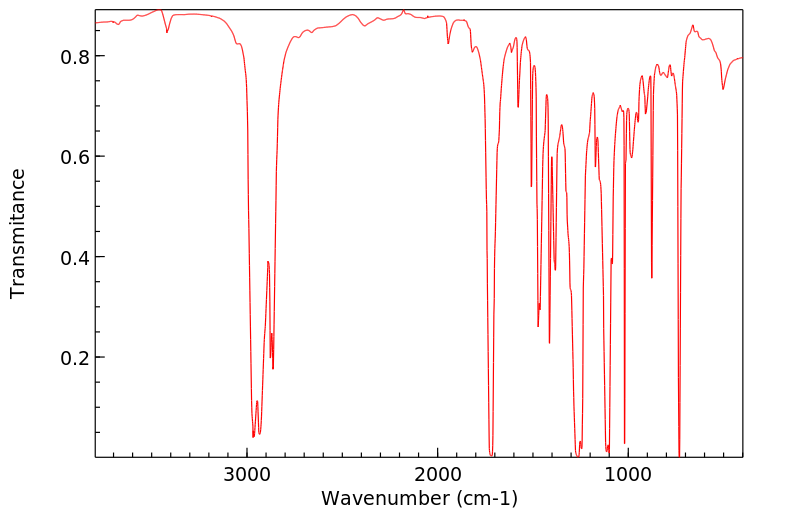二己基对苯二甲酸酯 | 1818-96-8
中文名称
二己基对苯二甲酸酯
中文别名
——
英文名称
Terephthalsaeure-dihexylester
英文别名
dihexyl terephthalate;dihexyl benzene-1,4-dicarboxylate
CAS
1818-96-8
化学式
C20H30O4
mdl
——
分子量
334.456
InChiKey
MLIPQTRXLNTCRS-UHFFFAOYSA-N
BEILSTEIN
——
EINECS
——
-
物化性质
-
计算性质
-
ADMET
-
安全信息
-
SDS
-
制备方法与用途
-
上下游信息
-
文献信息
-
表征谱图
-
同类化合物
-
相关功能分类
-
相关结构分类
物化性质
-
保留指数:2460;2463;2460;2463;2469
计算性质
-
辛醇/水分配系数(LogP):7.7
-
重原子数:24
-
可旋转键数:14
-
环数:1.0
-
sp3杂化的碳原子比例:0.6
-
拓扑面积:52.6
-
氢给体数:0
-
氢受体数:4
安全信息
-
海关编码:2917399090
SDS
上下游信息
反应信息
-
作为反应物:参考文献:名称:BUYSCH, HANS-JOSEF摘要:DOI:
-
作为产物:描述:di-t-butyl terephthaloylbis(benzylcarbamate) 、 正己醇 在 caesium carbonate 作用下, 以 二甲基亚砜 为溶剂, 反应 12.0h, 以72%的产率得到二己基对苯二甲酸酯参考文献:名称:Cesium Carbonate Catalyzed Esterification of N-Benzyl-N-Boc-amides under Ambient Conditions摘要:We report a general activated amide to ester transformation catalyzed by Cs2CO3. Using this approach, esterification proceeds under relatively mild conditions and without the need for a transition metal catalyst. This method exhibits broad substrate scope and represents a practical alternative to existing esterification strategies. The synthetic utility of this protocol is demonstrated via the facile synthesis of crown ether derivatives and the late-stage modification of a representative natural product and several sugars in reasonable yields.DOI:10.1021/acs.orglett.9b02513
文献信息
-
Unsymmetrical dicarboxylic esters as bleach precursors申请人:Lever Brothers Company, division of Conopco, Inc.公开号:US05078907A1公开(公告)日:1992-01-07A bleach precursor compound, its peroxygen derivative, and detergent compositions containing these materials are disclosed herein. The bleach precursors structurally comprise a pair of different diesters, one ester containing an electrically-charged functional group. Perhydrolysis of the precursor in the presence of hydrogen peroxide and a basic aqueous media generates a peroxycarboxylic acid.
-
Production of Terephthalic Acid Di-Esters Using Alcohol-Amine Promoters申请人:Eastman Chemical Company公开号:US20150133683A1公开(公告)日:2015-05-14The invention is directed to a process for preparing a terephthalic acid di-ester. The process includes contacting terephthalic acid with a C 6 -C 10 alcohol in the presence of an organo-titanium catalyst and an alcohol-amine promoter under conditions effective to form a corresponding terephthalic acid di-ester. The promoter can improve the reaction time by as much as 50%.
-
Catalytic Depolymerization of Polymers Containing Electrophilic Linkages Using Nucleophilic Reagents申请人:Hedrick James Lupton公开号:US20110004014A1公开(公告)日:2011-01-06The disclosure relates to methods and materials useful for depolymerizing a polymer. In one embodiment, for example, the disclosure provides a method for depolymerizing a polymer containing electrophilic linkages, wherein the method comprises contacting the polymer with a nucleophilic reagent in the presence of a guanidine-containing compound. The methods and materials of the disclosure find utility, for example, in the field of waste reclamation and recycling.该披露涉及用于降解聚合物的方法和材料。例如,在一个实施例中,该披露提供了一种用于降解含有亲电键合的聚合物的方法,其中该方法包括在存在古铵基含化合物的情况下,将聚合物与亲核试剂接触。该披露的方法和材料在废物回收和循环利用领域中找到了应用。
-
Catalytic depolymerization of polymers containing electrophilic linkages using nucleophilic reagents申请人:——公开号:US20040127720A1公开(公告)日:2004-07-01A method is provided for carrying out depolymerization of a polymer containing electrophilic linkages in the presence of a catalyst and a nucleophilic reagent, wherein production of undesirable byproducts resulting from polymer degradation is minimized. The reaction can be carried out at a temperature of 80° C. or less, and generally involves the use of an organic, nonmetallic catalyst, thereby ensuring that the depolymerization product(s) are substantially free of metal contaminants. In an exemplary depolymerization method, the catalyst is a carbene compound such as an N-heterocyclic carbene, or is a precursor to a carbene compound. The method provides an important alternative to current recycling techniques such as those used in the degradation of polyesters, polyamides, and the like.
-
ELECTROCHROMIC MATERIAL申请人:Nagamura Toshihiko公开号:US20110149367A1公开(公告)日:2011-06-23The present invention relates to an electrochromic polymer compound composed of a hyperbranched polymer having electrochromic characteristics derived from a quaternary pyridinium salt, a terephthalic acid diester or a biphenyl-4,4′-diester structure, and a varnish, a thin film structure and an electrochromic device that are obtained by the polymer compound. The electrochromic material has high response speed, high coloring efficiency, and excellent repetition stability and can be used for a long time, and has excellent solubility in various solvents.
表征谱图
-
氢谱1HNMR
-
质谱MS
-
碳谱13CNMR
-
红外IR
-
拉曼Raman
-
峰位数据
-
峰位匹配
-
表征信息
同类化合物
(βS)-β-氨基-4-(4-羟基苯氧基)-3,5-二碘苯甲丙醇
(S,S)-邻甲苯基-DIPAMP
(S)-(-)-7'-〔4(S)-(苄基)恶唑-2-基]-7-二(3,5-二-叔丁基苯基)膦基-2,2',3,3'-四氢-1,1-螺二氢茚
(S)-盐酸沙丁胺醇
(S)-3-(叔丁基)-4-(2,6-二甲氧基苯基)-2,3-二氢苯并[d][1,3]氧磷杂环戊二烯
(S)-2,2'-双[双(3,5-三氟甲基苯基)膦基]-4,4',6,6'-四甲氧基联苯
(S)-1-[3,5-双(三氟甲基)苯基]-3-[1-(二甲基氨基)-3-甲基丁烷-2-基]硫脲
(R)富马酸托特罗定
(R)-(-)-盐酸尼古地平
(R)-(-)-4,12-双(二苯基膦基)[2.2]对环芳烷(1,5环辛二烯)铑(I)四氟硼酸盐
(R)-(+)-7-双(3,5-二叔丁基苯基)膦基7''-[((6-甲基吡啶-2-基甲基)氨基]-2,2'',3,3''-四氢-1,1''-螺双茚满
(R)-(+)-7-双(3,5-二叔丁基苯基)膦基7''-[(4-叔丁基吡啶-2-基甲基)氨基]-2,2'',3,3''-四氢-1,1''-螺双茚满
(R)-(+)-7-双(3,5-二叔丁基苯基)膦基7''-[(3-甲基吡啶-2-基甲基)氨基]-2,2'',3,3''-四氢-1,1''-螺双茚满
(R)-(+)-4,7-双(3,5-二-叔丁基苯基)膦基-7“-[(吡啶-2-基甲基)氨基]-2,2”,3,3'-四氢1,1'-螺二茚满
(R)-3-(叔丁基)-4-(2,6-二苯氧基苯基)-2,3-二氢苯并[d][1,3]氧杂磷杂环戊烯
(R)-2-[((二苯基膦基)甲基]吡咯烷
(R)-1-[3,5-双(三氟甲基)苯基]-3-[1-(二甲基氨基)-3-甲基丁烷-2-基]硫脲
(N-(4-甲氧基苯基)-N-甲基-3-(1-哌啶基)丙-2-烯酰胺)
(5-溴-2-羟基苯基)-4-氯苯甲酮
(5-溴-2-氯苯基)(4-羟基苯基)甲酮
(5-氧代-3-苯基-2,5-二氢-1,2,3,4-oxatriazol-3-鎓)
(4S,5R)-4-甲基-5-苯基-1,2,3-氧代噻唑烷-2,2-二氧化物-3-羧酸叔丁酯
(4S,4''S)-2,2''-亚环戊基双[4,5-二氢-4-(苯甲基)恶唑]
(4-溴苯基)-[2-氟-4-[6-[甲基(丙-2-烯基)氨基]己氧基]苯基]甲酮
(4-丁氧基苯甲基)三苯基溴化磷
(3aR,8aR)-(-)-4,4,8,8-四(3,5-二甲基苯基)四氢-2,2-二甲基-6-苯基-1,3-二氧戊环[4,5-e]二恶唑磷
(3aR,6aS)-5-氧代六氢环戊基[c]吡咯-2(1H)-羧酸酯
(2Z)-3-[[(4-氯苯基)氨基]-2-氰基丙烯酸乙酯
(2S,3S,5S)-5-(叔丁氧基甲酰氨基)-2-(N-5-噻唑基-甲氧羰基)氨基-1,6-二苯基-3-羟基己烷
(2S,2''S,3S,3''S)-3,3''-二叔丁基-4,4''-双(2,6-二甲氧基苯基)-2,2'',3,3''-四氢-2,2''-联苯并[d][1,3]氧杂磷杂戊环
(2S)-(-)-2-{[[[[3,5-双(氟代甲基)苯基]氨基]硫代甲基]氨基}-N-(二苯基甲基)-N,3,3-三甲基丁酰胺
(2S)-2-[[[[[((1S,2S)-2-氨基环己基]氨基]硫代甲基]氨基]-N-(二苯甲基)-N,3,3-三甲基丁酰胺
(2S)-2-[[[[[[((1R,2R)-2-氨基环己基]氨基]硫代甲基]氨基]-N-(二苯甲基)-N,3,3-三甲基丁酰胺
(2-硝基苯基)磷酸三酰胺
(2,6-二氯苯基)乙酰氯
(2,3-二甲氧基-5-甲基苯基)硼酸
(1S,2S,3S,5S)-5-叠氮基-3-(苯基甲氧基)-2-[(苯基甲氧基)甲基]环戊醇
(1S,2S,3R,5R)-2-(苄氧基)甲基-6-氧杂双环[3.1.0]己-3-醇
(1-(4-氟苯基)环丙基)甲胺盐酸盐
(1-(3-溴苯基)环丁基)甲胺盐酸盐
(1-(2-氯苯基)环丁基)甲胺盐酸盐
(1-(2-氟苯基)环丙基)甲胺盐酸盐
(1-(2,6-二氟苯基)环丙基)甲胺盐酸盐
(-)-去甲基西布曲明
龙蒿油
龙胆酸钠
龙胆酸叔丁酯
龙胆酸
龙胆紫-d6
龙胆紫








